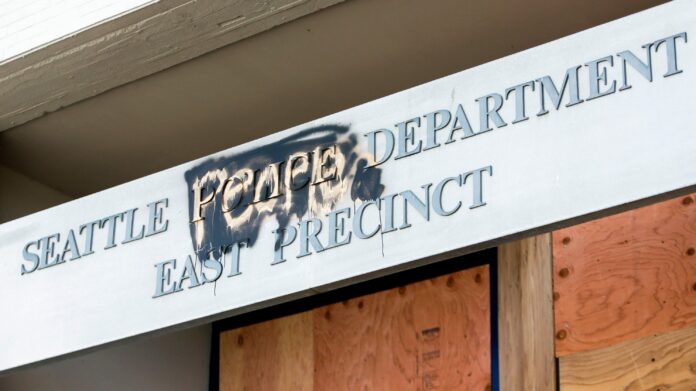CLOSE
After a Seattle Police precinct left a violent protesting area, protests became peaceful and they dubbed it the Capitol Hill Autonomous Zone, or CHAZ.
Storyful
In Seattle, a group of peaceful protesters have cornered off several city blocks and established the Capitol Hill Autonomous Zone – a sort of protest haven where artists paint murals, speakers discuss topics of racial equity, snacks are handed out for free and virtually no police are in sight.
President Donald Trump has branded the protest society as a group of “ugly Anarchists” and “Domestic Terrorists,” but the city’s mayor says Trump doesn’t get it. It’s a group of people gathering lawfully and exercising their First Amendment right of free speech, said Mayor Jenny Durkan.
“It is patriotism,” Durkan added.
The group gathered after Seattle police abandoned a precinct in the Capitol Hill neighborhood on Monday and effectively handed the area over to the protesters they had clashed with for days.
According to media reports from around the area, the Capitol Hill Autonomous Zone, or CHAZ, has a festival-like energy where people are peacefully gathering and discussing how to better the world in an experiment of a society without police amid calls around the country to “defund” departments.
‘Go back to your bunker’: Seattle mayor, Washington governor fire back at Trump threat to handle protests
Where is the Capitol Hill Autonomous Zone?
According to a Seattle Times map of the area, the zone spans several city blocks. It runs east to west along East Pine Street from 10th to 13th Avenues East. On 12th Avenue East, the zone extended down to East Pike Street. Some tents and a community garden have been set up in Cal Anderson Park, which runs along East Pine Street.
Capitol Hill is a neighborhood northeast of downtown Seattle and the famous Pike Place Market. The neighborhood is popular with many young residents in the city and home to many diverse artistic spaces, restaurants and Cal Anderson Park, named after Washington’s first openly gay legislator.
What does ‘defund the police’ mean? Why some say ‘reform’ is not enough
How did protesters first occupy the area?
Seattle, like most cities in the United States, saw major protests in the days that followed George Floyd’s killing in the custody of Minneapolis police.
For days, protesters and police in riot gear faced off nightly outside the Seattle Police Department’s East Precinct.
Autoplay
Show Thumbnails
Show Captions
In response to outcries against the tactics used by police in Seattle to control the crowds, Durkan promised at a news conference last week there would be a 30-day ban on the use of CS gas, commonly known as tear gas.
Despite that ban, police used tear gas to disperse demonstrators over the weekend, prompting a new wave of outrage from activists and City Council members. In response, the Seattle Police Department removed barricades from outside the East Precinct.
The Seattle Times reported that after the police barricades were removed, demonstrators quickly moved in with their own barricades and closed the area to vehicles.
Seattle Police Chief Carmen Best said Thursday it was her decision to use tear gas after the ban, as she said officers believed there could be violence, but it was not her decision to surrender the building, per the Times.
What’s the scene like inside the Capitol Hill Autonomous Zone?
News reports describe the occupied area as peaceful and safe. The words “Black Lives Matter” were painted on East Pine Street. Free food has been handed out at a “No Cop Co-op.” Speakers, poets and other performers share ideas and art.
A sign on the abandoned police precinct reads that the building is “property of the Seattle people.” The Seattle Times reported that some protesters hope to turn the building into a community center.
A community garden has also been planted in Cal Anderson Park. “We’re forced to build new plots because people are giving us so many plants,” Marcus Henderson, who was working in the gardens, told the Seattle Times.
Francis Vann, a 15-year-old high school freshman, told the newspaper that the movement happening inside the area is being driven by young people.
“A lot of times, the older people criticize the young people for how we choose to show our grief,” Vann said. “It kind of takes a lot to stir up emotions with the young people, but once we’re mad, we’re mad. And we’re mad. It’s the young people’s energy that’s out here and the old people’s wisdom that’s keeping us out here.”
Are businesses being threatened?
No.
Seattle police claimed earlier this week that some businesses housed inside the area are being extorted and forced to pay a fee to operate in the area. Best said Thursday that claim was false. “That has not happened affirmatively,” Best said, per the Seattle Times. “We haven’t had any formal reports of this occurring.”
Restaurant owners told the newspaper the protest has actually been good for business with more walk-ups. “This protest has not hurt us at all,” Bok a Bok Chicken co-owner Brian O’Connor told the Seattle Times.
Will police return to the area?
Police officials have said they plan to return to the abandoned precinct, but there is no timeline.
“We don’t want to introduce additional flashpoints,” Durkan said at a news conference about police’s potential return, the Seattle Times reported.
The Seattle Times reported that a group of officers were spotted at the police precinct Thursday evening and that there was a brief confrontation with protesters. Some protesters claimed they were pepper sprayed during the incident, the newspaper reported.
Contributing: William Cummings and The Associated Press
Read or Share this story: https://www.usatoday.com/story/news/nation/2020/06/12/seattle-protest-chaz-capitol-hill-autonomous-zone-police-free/3173968001/
